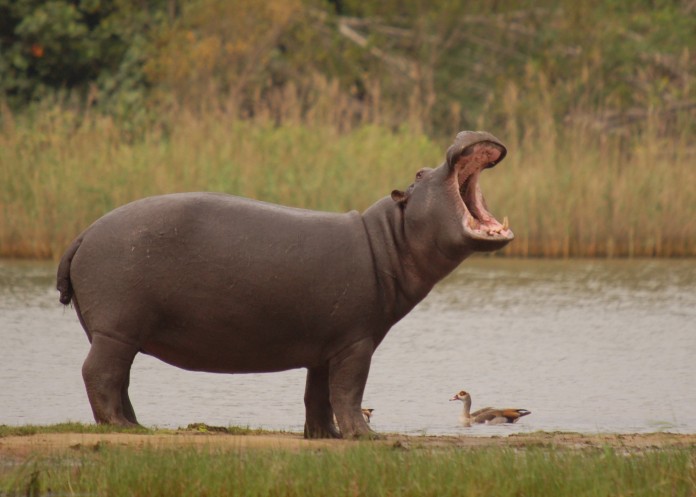Kruger Culling: Beyond hungry neighbours and bulging biomass

This is a story about too much hippo poo in the Kruger National Park, hungry neighbours and rain that just won’t fall. It’s also about culling, but the park doesn’t like the word and prefers harvesting. Either way, rangers have been out with their rifles and the Skukuza abattoir is open for meat processing.
Let’s begin with the poo – something hippos are pretty good at producing in large volumes. Kruger is in the grip of a severe drought. Rivers are drying, pools are emptying and grass is in short supply for herbivores.
Hippos – all 7 500 of them in the park – need water or they get sunburned. So they head for whatever pools are available to them, crowd up, munch and defecate. The result poisons the water for everything else. So ‘harvesting a sustainable resource’, ie killing, has begun.
According to William Mabasa, the park’s communications officer, ‘allowing natural attrition to take its course is probably ecologically the best. But it ignores moral issues such as allowing animals to die and rot in the face of the huge need in neighbouring areas.’ Best, then, to pot them before they expire and haul them off to the abattoir.
Buffalo harvesting isn’t about poo. According to Mabasa, ‘we have committed ourselves to contribute to feeding schemes of school children in neighbouring areas, hence the sustainable use of buffalo. There are 47 000 of them at a time when the biomass in the park is at it’s highest ever.’ The harvest, he says, would be no more than 4% – that’s around 1880.
In view of the large populations of these herbivores as well as the mortalities the park has already observed and anticipated, ‘these numbers are ecologically not significant.’
The park has an interesting justification for this harvesting which goes beyond hungry neighbours and bulging biomass. Before Europeans arrived and declared a park, there were, says Mabusa, around 15 000 hunter-gatherers using it as their shopping mall.
‘We greatly underestimated their role in shaping this ecosystem. [By removing them] we removed this driver from the Kruger ecosystem and we are researching ways to simulate their role again [in keeping down numbers] .
‘It would not be possible or suitable to reintroduce humans, but rather to simulate their influence in certain areas.’
So culling, which has had extremely bad press in the past, is not what they’re doing, he says. They are, instead, ‘focusing on alleviating pressure on sensitive areas’ in line with pre-modern precedents. Other herbivores may be considered in future.
Exactly how many animals have been ‘cropped’ so far? Apart from the comment that it is ‘generally between 1% and 4%,’ Mabasa did not give figures. The numbers, he said, are not cast in concrete as it’s ‘not possible to determine how the situation will unfold as the drought further develops.’
A report in Africa Geographic in June said that 59 hippos had been culled, another 100 hippos and 300 buffalo were in the firing line. Since then no news has emerged about cull numbers or how and to whom meat is being distributed in surrounding communities.
It’s also not clear whether the core of the problem is poo, poverty or the absence of pre-modern humans at a time when the rain just won’t fall. Whatever the driver, Skukuza’s abatoir, once infamous for the large number of elephants that passed across its chopping tables, is once again open for business.
(Source: Conservation Action Trust)


